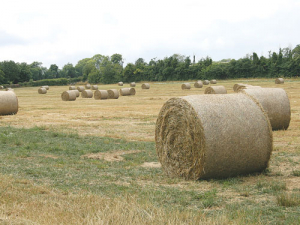Turning data into dollars
If growing more feed at home adds up to $428 profit per tonne of dry matter to your bottom line, wouldn’t it be good to have a ryegrass that gets you there quicker?
 In practice, silage is often not made at the optimal time, and little attention is paid to the silage-making process.
In practice, silage is often not made at the optimal time, and little attention is paid to the silage-making process.
Making high-quality pasture silage should not be difficult, but it must be viewed as a supplementary feed, rather than just a necessity to manage pasture.
NZ experimental results indicate that increasing silage quality by 2.3 MJ ME/kg DM increased MS production by 13, 17 and 41% in spring, summer and autumn, respectively. Higher quality feed will also increase BCS gain/kg DM eaten.
Making of silage should only be done from a true surplus and the objective is to preserve as many of the original nutrients as possible. In practice, however, silage is often not made at the optimal time, and little attention is paid to the silage-making process.
When grass is cut and left in a heap, it rots! Silage-making is the process of ‘pickling’ pasture to reduce the pH (acidity) to a level that stops the feed ‘rotting’ (i.e. stops microbial activity).
This is achieved through packing the pasture and covering it with plastic to exclude air, while microorganisms burn the sugars in the grass to produce lactic and acetic acid. If the silage is exposed to air (e.g. torn plastic) a chain reaction occurs that reduces silage quality.
Pasture silage can be made either in a field stack, a pit/concrete bunker (on top of the ground) or as bales. Provided the quality of the material going into the silage is the same and proper attention is paid to compacting and covering the pasture, pasture silage quality should be the same from either stack/pit or baled silage.
The decision to make bales or stack/pit silage is generally dependent on the farm system, the method of feeding silage and the infrastructure available for silage storage.
- Baled silage is more costly but enables flexibility of crop size and storage location onfarm and feeding out of small amounts on set occasions.
- Stack silage can also be stored in many locations and is cheaper than baled silage.
- Pit/bunker silage does not offer flexibility in storage but when properly used will result in less wastage. Pit silage is easier to compact and therefore to expel air.
Legal controls on the movement of fruits and vegetables are now in place in Auckland’s Mt Roskill suburb, says Biosecurity New Zealand Commissioner North Mike Inglis.
Arable growers worried that some weeds in their crops may have developed herbicide resistance can now get the suspected plants tested for free.
Fruit growers and exporters are worried following the discovery of a male Queensland fruit fly in Auckland this week.
Dairy prices have jumped in the overnight Global Dairy Trade (GDT) auction, breaking a five-month negative streak.
Alliance Group chief executive Willie Wiese is leaving the company after three years in the role.
A booklet produced in 2025 by the Rotoiti 15 trust, Department of Conservation and Scion – now part of the Bioeconomy Science Institute – aims to help people identify insect pests and diseases.
President Donald Trump’s decision to impose tariffs on imports into the US is doing good things for global trade, according…
Seen a giant cheese roll rolling along Southland’s roads?